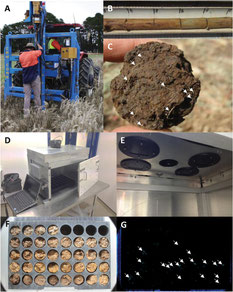BarleyMicroBreed - Core Break Imager for Root Phenotyping [2023-2024]
Core-Break Root Imager for the Field

Crop root architectural traits are a key but yet underutilized target for pre-breeders. Incorporation of root architecture traits into new cultivars requires phenotyping. It is beneficial to rapidly and directly phenotype root architectures in the field, avoiding laboratory studies that may not translate. A combination of soil coring and core-break counting can directly phenotype root architecture traits of depth and distribution in the field through to grain setting, but labour costs are high with this method if cores are analyzed manually (and particularly if roots are rinsed). Within the EU BarleyMicroBreed project (https://barleymicrobreed.eu/) we will develop a portable fluorescence imaging system to automate root counting in barley phenotyping - analyzing soil cores of 600 varieties with image analysis software directly in the field to determine the root depth distribution. Field validation is done by BOKU Vienna staff during summers / field seasons 2023 and 2024.
Previous approaches in wheat have shown that the correlation of measurements with root length density of (washed) soil cores exceeds that of human operators (Wasson et al. 2016), and can achieve a higher throughput and thus efficiency.
As the phenotyping platform has great potential to help capture more information on root architectural traits in the field, we are looking forward to testing the currently constructed prototype under field conditions in the BOKU barley trials, and to develop it into a versatile, reliable tool for the global root phenotyping community. Stay tuned!
Selected Publications on the Core Break Method for Root Field Phenotyping
- Wasson A, Bischof L, Zwart A, Watt M. 2016. A portable fluorescence spectroscopy imaging system for automated root phenotyping in soil cores in the field. J Exp Bot., 67(4):1033-43.
